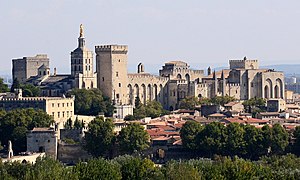Palais des Papes
| Palais des Papes | |
|---|---|

The Palais des Papes
|
|
| Location | Avignon, France |
| Coordinates | 43°57′03″N 4°48′27″E / 43.9508°N 4.8075°ECoordinates: 43°57′03″N 4°48′27″E / 43.9508°N 4.8075°E |
| Official name: Historic Centre of Avignon: Papal Palace, Episcopal Ensemble and Avignon Bridge | |
| Type | Cultural |
| Criteria | i, ii, iv |
| Designated | 1995 (19th session) |
| Reference no. | 228 |
| UNESCO region | Europe and North America |
The Palais des Papes (English: Papal palace, lo Palais dei Papas in Occitan) is a historical palace in Avignon, southern France, one of the largest and most important medieval Gothic buildings in Europe. Once a fortress and palace, the papal residence was the seat of Western Christianity during the 14th century. Six papal conclaves were held in the Palais, leading to the elections of Benedict XII in 1334, Clement VI in 1342, Innocent VI in 1352, Urban V in 1362, Gregory XI in 1370 and Antipope Benedict XIII in 1394.
The Palais is actually two joined buildings: the old palais of Benedict XII, which sits on the impregnable rock of Doms, and the new palais of Clement VI, the most extravagant of the Avignon popes. Together they form the largest Gothic building of the Middle Ages, it is also one of the best examples of the International Gothic architectural style. The construction design was the work of two of France’s best architects, Pierre Peysson and Jean du Louvres and the lavish ornamentation was the work of two of the best students of the School of Siena (Italy), Simone Martini and Matteo Giovanetti.
In addition, the papal library housed in the Palais (the largest in Europe at the time with over 2,000 volumes), attracted a group of clerics passionate in the study of "belle-lettres", amongst them the founder of Humanism, Petrarch. At the same time, composers, singers and musicians were drawn to the Great Chapel of the Palais. It was there that Clement VI appreciated the Mass of Notre-Dame of Guillaume de Machaut, there that Philippe de Vitry at the pope’s invitation presented his Ars Nova and there that Johannes Ciconia came to study.
...
Wikipedia
